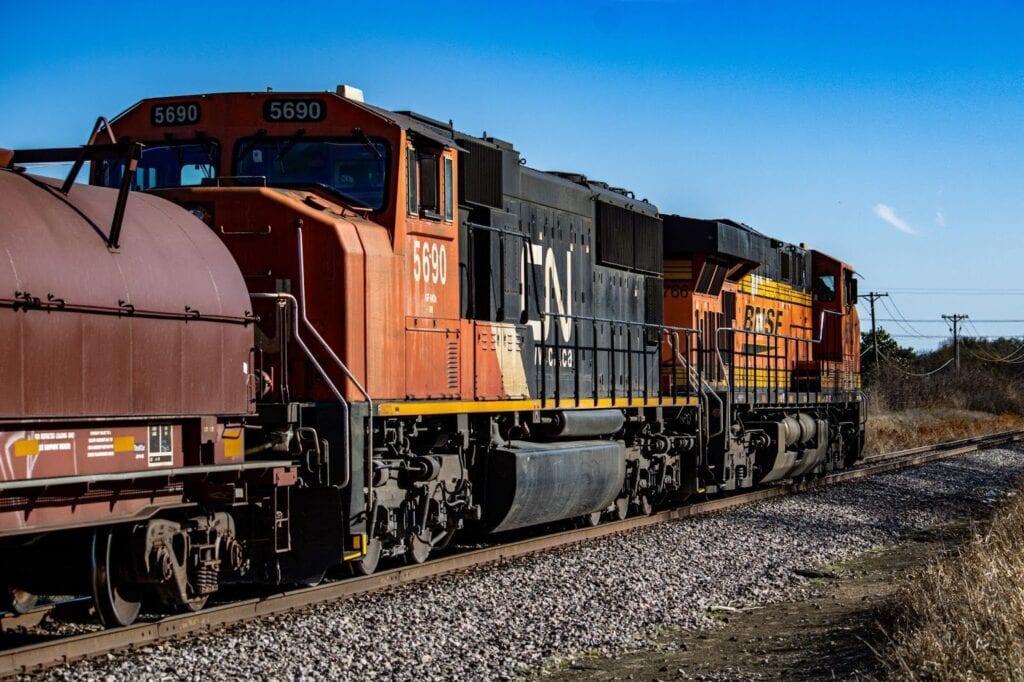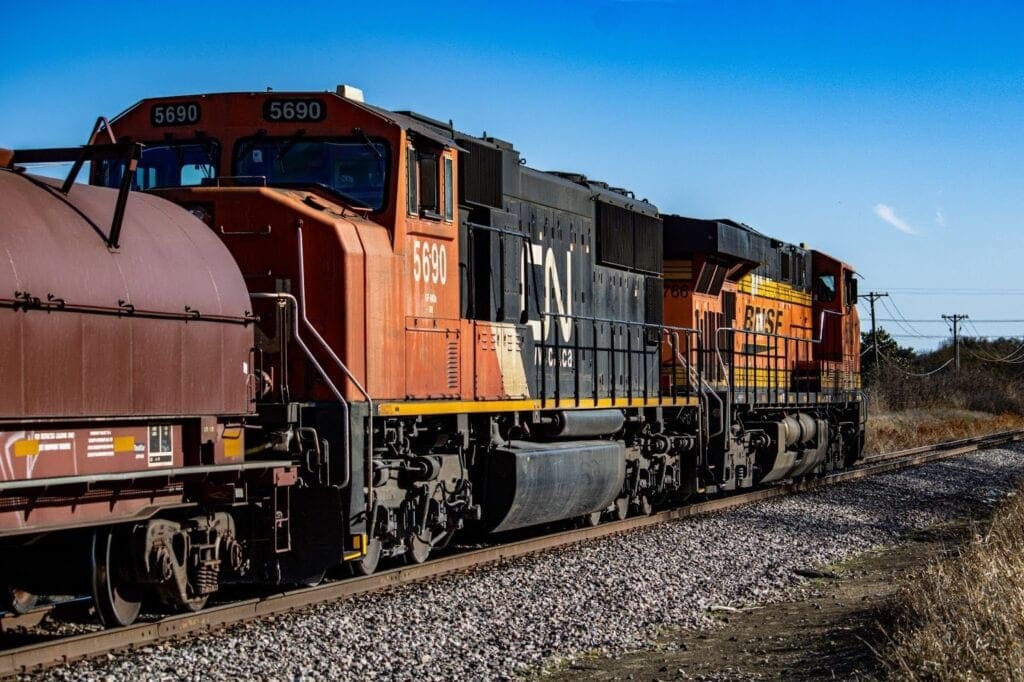Types of Train Cars: Definition and Use of Modern Rail Cars

Types of Freight Trains: Definition and Use of Modern Rail Cars

Freight trains have been the backbone of modern industries for centuries, ensuring the seamless movement of commodities from one place to another.
As the transportation landscape evolved, so did the types of freight trains, with rail freight transport growing increasingly sophisticated to handle diverse cargo needs. If you’ve ever wondered about the intricacies of these mighty movers, you’re in the right place.
This article delves into the various train cars and their specific functions in the vast world of rail freight.
Modern Freight Trains
Rail freight has a history intricately intertwined with the Industrial Revolution and subsequent global expansion. As factories burgeoned and demands for goods soared, trains became the lifeline connecting manufacturers to markets.
From the iconic steam engines of yore to the technologically advanced modern freight trains of today, the world of rail transport has witnessed dramatic transformations. Globally, each region has its unique twist on freight rail.
For instance, American railroads might prioritize certain types of cargo due to the vast distances they cover. At the same time, European networks might focus on faster intermodal transportation to navigate the continent’s closely-knit countries.
Boxcars
Boxcars are arguably the most recognizable rail cars for their enclosed structure and versatility. They are typically used for transporting general cargo, especially items that need protection from the elements, like manufactured goods, perishables, and commodities.
Inside, they often have a solid roof, walls, and adjustable shelves to accommodate varying cargo sizes. In some instances, boxcars are even refrigerated (known as refrigerated boxcars) to transport perishable goods such as fruits, vegetables, and meats.
Their design ensures that goods reach their final destination in optimal condition, making them a popular choice for diverse freight shipping needs.
Flatcars
Flat cars, as the name suggests, have a flat, platform-like structure with no overhead roof or enclosing sides. This design makes them especially useful for transporting oversized cargo such as vehicles, large equipment, and wind turbines. Flat cars are versatile enough to transport oversized and heavy items, including military vehicles.
Their open structure allows for easy loading and unloading of bulky items. In addition to heavy machinery, flat cars can be utilized for transporting building materials like lumber or steel pipes, which might need to be fixed in enclosed rail cars.
Another variation is the “center beam” flatcars, designed explicitly with tie-down points for transporting stacked lumber. They provide an efficient method to move large quantities of goods, making them indispensable in rail freight transport.
Tanker Cars
Tanker cars, part of the freight train types lineup, are the backbone for transporting liquids across vast rail networks. Their design ensures safe and voluminous transport, essential for carrying everything from crude oil to liquefied petroleum gas.
These rail cars provide industries with a reliable method of transporting large quantities of liquid commodities, especially when pipelines are unavailable or impractical. The American railroad system, for instance, sees countless tanker cars daily, showcasing their indispensability.
Their specialized build, from pressurized tank cars for volatile chemicals to insulated ones for sensitive materials, exemplifies the meticulous thought put into rail freight shipping, ensuring product safety and minimizing health risks during transit.
Hopper Cars
Hopper cars, frequently seen on freight railroads, epitomize efficiency in transporting bulk commodities like coal, grain, and iron ore. Designed with a bottom opening, they facilitate quick unloading, proving pivotal in industries requiring swift turnarounds.
Covered hopper cars, a variant, protect materials such as crops or chemicals from external elements. Their ability to handle vast quantities while expediting the unloading process has made them a staple in rail freight transport.
Their use is widespread across continents, underpinning the transport of essential raw materials that fuel economies. With the evolution of rail transport, modern hopper cars come equipped with advanced features, minimizing wastage and ensuring cargo integrity during long distances.
Coil Cars
Coil cars, an integral part of modern freight trains, transport rolled steel coils, which are pivotal for various manufacturing plants. These train cars are uniquely structured with troughs or cradles to securely hold coils, ensuring they don’t shift during transit.
Given the weight and size of steel coils, which can be used for products ranging from automobiles to household appliances, the design of coil cars is critical to ensure safe transport. Their importance isn’t understated in today’s industrial landscape, where timely and damage-free deliveries are paramount.
As rail networks expand and industries grow, the role of coil cars in efficient and safe rail freight transport continues to amplify.
Refrigerator Cars
Refrigerator cars, often termed “reefers,” represent the fusion of technology and rail transport. Designed to transport perishables like meats, fruits, and vegetables over long distances, these rail cars come equipped with cooling systems.
This ensures that goods remain fresh, addressing the challenges associated with shipping perishables. Refrigerated boxcars have been instrumental in transforming the food supply chain, guaranteeing freshness from farm to table.
Given the vast expanses covered by American railroads, for instance, refrigerator cars are essential for maintaining the quality of food products. As we progress, the reliance on such cars only intensifies, given the increasing demand for fresh produce and products in far-off markets.
Gondolas
Gondolas are open-topped rail cars used widely across the rail freight industry. With a design suitable for bulk cargo, they’re ideal for transporting commodities such as minerals, coal, scrap metal, and lumber.
The lack of a roof provides the flexibility of loading large quantities of oversized cargo from the top or the side. Their robust build ensures that even heavyweight items like steel or machinery are safely transported.
When moving through the rail network, gondolas remain the preferred choice for industries requiring an efficient transport of solid, heavy materials.
Centerbeam Cars
Centerbeam cars, distinguished by their central partition or ‘centerbeam’, primarily transport lumber and building materials like fence posts and plywood. The design facilitates balanced loading on either side of the beam, maximizing cargo space.
Predominantly seen in North American railroads, these cars have tie-down points to secure loads, ensuring materials reach their final destination undamaged.
As construction and infrastructure projects continue to rise, the demand for centerbeam cars remains high, ensuring lumber and related materials get to manufacturing plants and construction sites timely.
Intermodal Cars
Intermodal cars, also known as well cars, play a pivotal role in the modern supply chain. These cars are designed to transport intermodal containers, accommodating both domestic shipments and international trade.
By allowing seamless cargo transition from ships to trains and trucks, they streamline the shipping process, making it cost-effective and efficient. Key in intermodal traffic, they are the backbone of today’s global trade system.
Their ability to handle double-stack containers optimizes space and ensures a larger volume of goods can be transported with fewer trains, championing the cause of efficient freight shipping.
Specialty Cars
Specialty cars cater to unique transport needs that regular rail cars can’t address. Many types of cargo necessitate the use of specialized cars tailored to specific shipping needs. These might include transporting vehicles, wind turbines, oversized project cargo, or specific perishables requiring particular conditions.
For instance, autorack cars, a specialty car, are designed with multiple levels to efficiently transport vehicles, ensuring they’re protected from external elements during transit. Another example would be pressurized tank cars, used for certain gasses or liquids.
As industries evolve and requirements become more niche, specialty cars will continue to be developed and refined, showcasing the versatility of rail transport.
Autorack Cars
Autorack cars are specifically designed to transport passenger cars, trucks, and SUVs across vast distances. As the global automobile industry has expanded, so needs specialized rail transportation.
These enclosed rail cars usually consist of two or three levels to accommodate many vehicles efficiently, maximizing space and transport efficiency. Designed with protection in mind, autoracks ensure vehicles are safeguarded against external factors like weather, debris, or potential vandalism.
The construction of such cars involves meticulous engineering to provide easy loading and unloading of vehicles, ensuring minimal damage. Moreover, advanced locking systems ensure the stability of vehicles during transit.
Given the sheer number of vehicles produced and the need for distribution across various regions, autorack cars have become an indispensable part of the rail freight transport system, underpinning the automobile industry’s supply chain.
Well Cars
Well cars, sometimes referred to as double-stack cars, have revolutionized the realm of intermodal freight transport. These cars are distinctively designed with recessed sections, known as “wells”, allowing them to carry two intermodal containers, one stacked atop the other.
This innovative design significantly increases transport capacity, optimizing track space usage and reducing costs. Such efficiency is vital in today’s globalized trade environment. As products travel from factories in one continent to consumers in another, the ability to transport a larger volume of goods using fewer trains becomes invaluable.
Furthermore, the double-stack design minimizes the chances of cargo toppling over, ensuring safer transit. As the world leans more into international trade, the importance and reliance on well-cars in ensuring the smooth transition of goods across borders only continue to grow.
Spine Cars
Spine cars represent a unique evolution in train car design, tailored explicitly for intermodal services. At a glance, these cars, a subset of flatcars, might seem minimalist; they only consist of longitudinal assemblies resembling a spine.
This design isn’t merely aesthetic. Spine cars are inherently lightweight compared to their traditional flatcar counterparts, translating to greater fuel efficiency and cost savings for rail operators. Their primary role is handling intermodal containers and truck trailers, a testament to their versatility.
The structure allows quicker loading and unloading, which is essential in fast-paced modern freight operations. Moreover, their design, by being lightweight, reduces wear and tear on tracks, further driving down operational costs. In the intricate ballet of modern logistics, spine cars dance gracefully, bridging the gap between road and rail, proving their mettle in efficient freight transport.
The Significance of Containerization in Freight Shipping
Containerization revolutionized the world of freight shipping, making it a cornerstone of global trade. Introduced in the mid-20th century, the standardized containers allowed for the seamless movement of goods across different modes of transport – from ships to trucks and trains.
As a result, ports became more efficient, ship loading times plummeted, and global trade costs were significantly reduced. Modern technology has further propelled this, introducing innovations such as tracking systems and automated cranes, making the entire process more streamlined.
Consequently, economies have become deeply interconnected, with goods transported across continents in record time, emphasizing containerization’s immense impact on modern shipping and global economic dynamics.
FAQs
Dive into some commonly asked questions about freight trains and railroads.
What are the four types of trains?
Passenger trains, freight trains, monorails, and high-speed trains.
What is the most common freight train?
The most common freight train is the mixed freight train.
What is a Z freight train?
A Z freight train is a high-priority intermodal freight train.
What are the three types of railroads?
Class I, Class II, and Class III railroads.
Types of Freight Cars in Rail Transport
Rail freight transport has diversified to cater to various cargo needs, boasting a range of rail car types suitable for almost any type of cargo, like boxcars, hopper cars, and tanker cars.
These specialized rail cars ensure efficient and safe conveyance of items, from perishables to bulk commodities, emphasizing the unique designs and functionalities of different types of rail cars tailored for transporting specific cargo.
Modern freight trains have evolved significantly, showcasing the adaptability and innovation within the rail transport sector.
